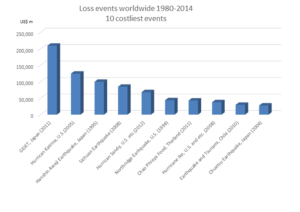When a large earthquake occurs at the bottom of the ocean, the ground suddenly lifts and sinks. This movement directly affects the surface of the ocean, creating large waves that spread far and wide. This is the typical way an earthquake-induced tsunami starts. Smaller earthquakes do not cause tsunamis because the shape of the ocean floor does not change much. Also, if an earthquake occurs very deep in the ocean, tsunamis do not occur because their effects do not reach the surface of the ocean. Large tsunamis are caused by huge earthquakes in deep ocean trenches, which are caused by the subduction of the Earth’s plates. In this type of earthquake, the ocean surface is pushed up or pulled down. On the side where the ocean is pushed up, the waves rise; on the side where it is pulled down, the ocean lowers. Which of the two is the first wave of a tsunami has a lot to do with how you perceive the danger and how you escape; the nature of the tsunami that hit Sumatra in 2004 (magnitude 9.0) caused the southern part of Thailand to be hit by a wave that pulled the ocean down, and the nature of this tsunami increased the damage.
「Thailand」カテゴリーアーカイブ
Day_60 : 1988 Landslide disaster in Thailand
1988 The landslide disaster was the turning point in Thai society. The major landslide hit Nakhon Si Thammarat province in the south of Thailand, and the number of casualties was approximately 230. This is assumed to be caused by deforestation. After recognizing the situation, the King talked to the people in Thailand about protecting the environment on December 4, 1989. This became a trigger to facilitate environmental policy and movement in Thailand. In 1992, environment-related agencies, organizations, funds, and others were established. This is the same year as the UN Earth Summit.
Day_172 : Hollywood Movie “The Beach” and The 2004 Indian Ocean Tsunami in Thailand
Past writings are to be disclosed little by little, with some changes.
>>>>>>>>>>>>>>>>>>>>>>>>>>>>
The Supreme Court of Thailand ordered 20th Century Fox Inc. and its local subsidiaries to restore the ecosystem of Phi Phi Island, acknowledging that the company degraded the environment around Phi Phi Lei Island for the filming of the Hollywood movie “The Beach” in 2000 on December 7, 2006. The film, starring Leonardo DiCaprio, has made great strides in the development of tourism on the island and displaced many tourists, but the island was one of the worst affected areas by the Indian Ocean Tsunami of late 2004, and many tourists lost their lives.
 Flyer: The Movie “Tha Beach”
Flyer: The Movie “Tha Beach”
Tourism development for economic development and environmental issues lay largely in the background of why Koh Phi Phi was one of the hardest-hit areas by the tsunami in Thailand.
It all started with the baht crisis that hit the Thai economy in 1997. In the early 1990s, the Thai government established the Ministry of Science, Technology and Environment and the Environmental Fund, enacted a number of environmental laws and enacted a national environmental boom, which began in the early 1990s. A prime example is a controversy over the alteration of the environment for Hollywood movies, known as “the beach controversy,” which began in 1998.
This was sparked by an attempt by a film crew to alter the landscape of Maya Beach on the island of Phi Phi Ley. For the filming of football game scenes, the sandy beach was widened by bulldozers, and non-indigenous coco palm trees were imported and planted on the beach to create an image of a tropical paradise. The Royal Forest Department’s decision to approve the alteration was a measure that went so far as to bend the law in order to attract international investment with the aim of reviving the Thai economy.
This has led to the neglect of nature conservation, and local NGOs and others have begun to investigate and prosecute the environmental degradation around the island.
The tsunami that struck Phi Phi Island on December 26, 2004, occurred in the midst of such tourism development.
Now, two years after the tsunami, the island of Phi Phi Lei and the surrounding areas have regained their natural beauty, having been cleared of the man-made nature created by the tsunami.
Mr. Songboon of TOT Krabi Province, a major telecommunications company in Thailand, said, “I’ve been watching Phi Phi Island for a long time, but the sea was the dirtiest just before the tsunami. He said with great emotion, “The beaches around the area after the tsunami have regained the beauty of 10 years ago. He is currently staying on Phi Phi don Island to set up an internet connection.
 Picture: Maya Beach
Picture: Maya Beach
Mr. Spar, who runs a dive shop in the hard-hit Thongsai Bay, said, “For a while after the tsunami, we were in a vicious circle, with fewer customers and higher rates for the limited accommodations available to stay, and even fewer customers. However, now the sea itself is getting very clean, the city has recovered a lot, and the customers have returned. Management is getting a little better, too. and a glimpse of hope.
 Picture: Thongsai Bay
Picture: Thongsai Bay
Supreme Court decision that seems too little, too late. It will be interesting to see how Phi Phi Island rebuilds and learn from the experience of the tsunami and its recovery process.
Reference:
Natural Disasters and Disaster Management in Thailand
Natural Disasters and Disaster Management in Thailand
Nikkan Berita (edited and rearranged for this post)
Nikkan Berita Writer’s Archive December 30, 2006
Day_141 : Flood disasters in Thailand : 14 deaths are reported in south (7 Dec. 2016)
Thai News mentioned that “Thailand declares disaster zones after floods kill 14“.
The created National Disaster Risk Assessment Mapping indicates flood disaster countermeasure is the first priority in Thailand(Day_93 ).
http://disasters.weblike.jp/disasters/archives/2935
The Thai Disaster Chronology also suggests that southern provinces of Thailand are the most vulnerable areas to the floods (Day_134,135). We can learn from the data.
http://disasters.weblike.jp/disasters/archives/3404
http://disasters.weblike.jp/disasters/archives/3437
Related articles across the web
Day_137 : Aging Asia to Natural Disasters -Thailand(2)-
Day_68 indicates Thai population in 2012 was 64,460,000 and the proportion of those over 65 is 8.6 percent (11 percent in 2016) compared to 3.1 percent in 1970. This shows that Thailand is facing an aging society and the World Population Prospects* predicts this trend will accelerate. This situation is not exclusively in Thailand, but can likewise be viewed in almost all Asian nations. In addition, Asia is the most vulnerable in terms of natural disasters such as 7 of 10 of the deadliest natural disasters (1980-2014) took place in this region(Day_79). The World Bank mentions how Thailand faces the aging society from an economic development perspective, however, we also need to recognize this from a disaster reduction viewpoint. Okushiri island case can give us a significant insight(Day_75). This gives us a challenge of how disaster-resilient society can be established in the situation.
The World Bank notices**:
The Thai population is aging rapidly. The declining share of the working-age population will affect economic growth.
– As of 2016, 11% of the Thai population (about 7.5 million people) are 65 years or older, compared to 5% in 1995.
-By 2040, it is projected that 17 million Thais will be 65 years or older – more than a quarter of the population.
-Together with China, Thailand has the highest share of elderly people of any developing country in East Asia and Pacific.
-The primary driver of aging has been the steep decline in fertility rates, which fell from 6.1 in 1965 to 1.5 in 2015, as a result of rising incomes and education levels and the successful National Family Planning Program launched in 1970.
-The working-age population is expected to shrink by around 11% as a share of the total population between now and 2040 – from 49 million people to around 40.5 million people.
–This decline in the working-age population is higher in Thailand than in all other developing East Asia and Pacific countries, including China.
https://disasterresearchnotes.site/archives/2785
https://disasterresearchnotes.site/archives/2753
* World Population Prospects
https://esa.un.org/unpd/wpp/
** World Bank, 2016
Thailand Economic Monitor – June 2016: Aging Society and Economy
Disaster data and statistics can be referred by the following link:
http://www.preventionweb.net/english/professional/statistics/
Related articles across the web
Day_132_Area BCM (1)
In 2011, Great East Japan Earthquake and Tsunami (GEJET) disaster and the Chao Phraya River flood disaster made huge economic damages. They are in the top 10 costliest natural disasters (The very top and the 7th) in the world as you can see the following table.
Source: NatCatSERVICE/Munich RE 2016
From the historical point of views, the disaster trends from human sufferings to economic damages. The following figure shows the economic damage tendency is increasing with time and we can see the year of 2011 was an outstanding.
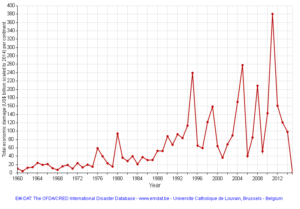
Source: EM-DAT
Especially, the globalization of the economic activities reflect these damages.In the event of large-scale disaster, a business sector is limited in its abilities to cope with disaster without the cooperative approach taken by the stakeholders of the public and private sectors in those areas.
With this situation, the concept of the Area Business Continuity Management (Area BCM) was revealed. This is a cooperative approach by those who wish to improve capacity for continuity and/or early recovery of business in their area in the event of disasters that affect the entire area(AHA CENTRE et al., 2015).
[Reference]
AHA CENTRE, JICA, et al., (2015) Planning Guide for Area Business Continuity: Area BCM Toolkits Version 2
sponsored link
Related articles across the web
Day_109 : Earthquake disasters in Thailand
The earthquake disaster is not so common in Thailand, therefore, that is why Thai people should consider the risk. They have a lack of experience.
The Earthquake Track is one of the useful websites to check the earthquakes in Thailand including neighboring countries. The recent earthquake can be confirmed
“Recent Earthquakes Near Thailand” site.
The below is a guide book for earthquake disaster reduction in Thai (especially for Thai people).
A Guide Book for Earthquake Disaster Reduction (Thai language)
There are some active faults in Thailand (Figure 1).

Figure 1 Active Fault Map in Thailand
We should know the BKK is one of the earthquake vulnerable areas because the
ground is not so firm.
A short essay about natural disaster risk mapping in Thailand was written as follows:
https://disasterresearchnotes.site/archives/2935
Day_101 : Deth toll tells
The following Figure 1 is the death toll by country after the 2004 Indian Ocean Tsunami disaster.
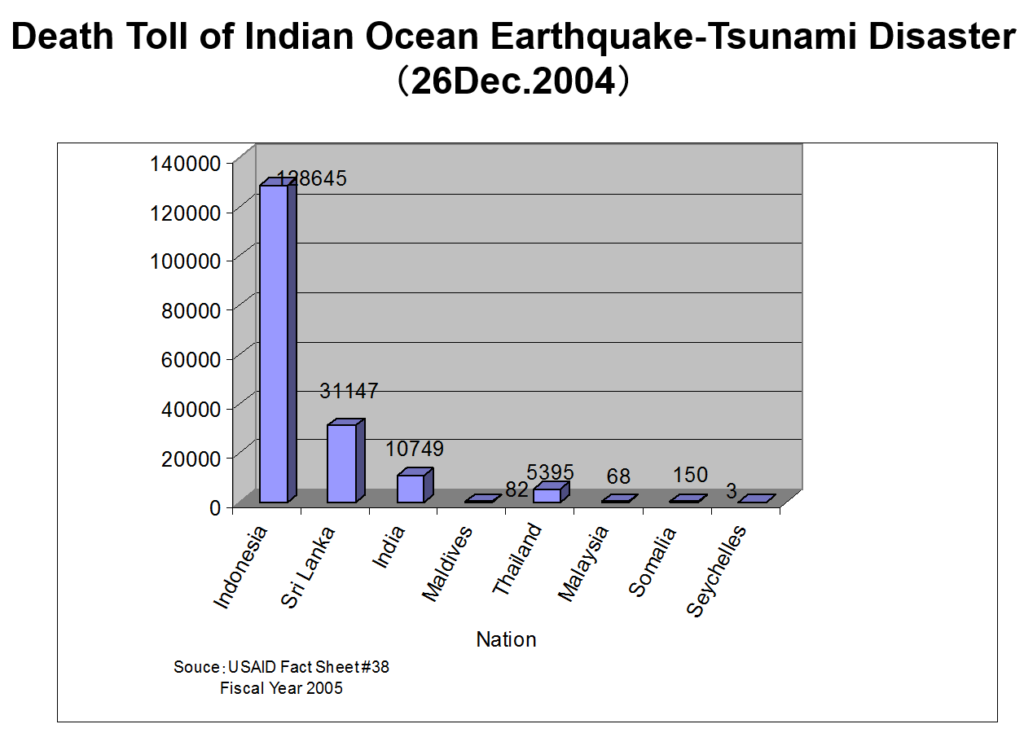
Figure 1 Death toll by country
Then Table 1 indicates the death toll flow of each country.
What can we say about this?
Table 1 The Death Toll Flow
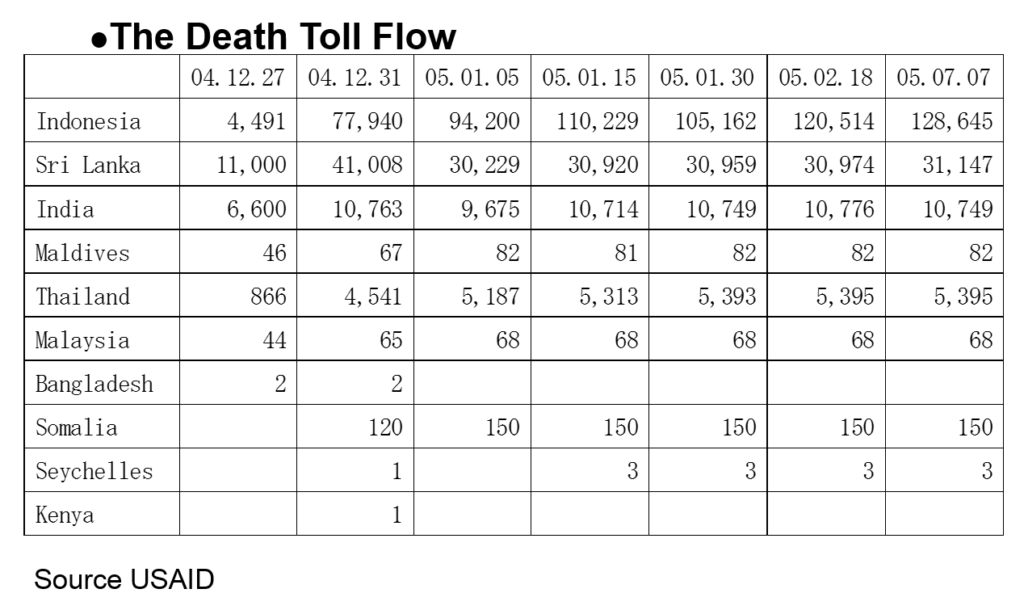
As you can see Table 1, the number of victims (deaths) is changing day by day. For instance, the number of deaths reported in Indonesia from 05.01.15 to 05.01.30 is decreasing. The death toll flow of Somaria looks somehow strange. If we can consider these kinds of views, we can understand that the reported death numbers reflect the social situations of the country. These views will be discussed later.
Next, Figure 2 shows the picture taken at the tsunami memorial meeting in Phang Nga province one year after the disaster. This definitely indicates so many foreigners were killed by the tsunami. Figure 3 support this fact. This is because the affected areas were sightseeing spots. Even Thai victims include so many visitors from all over the country.

Figure 2 The Picture of the Tsunami Memorial Board
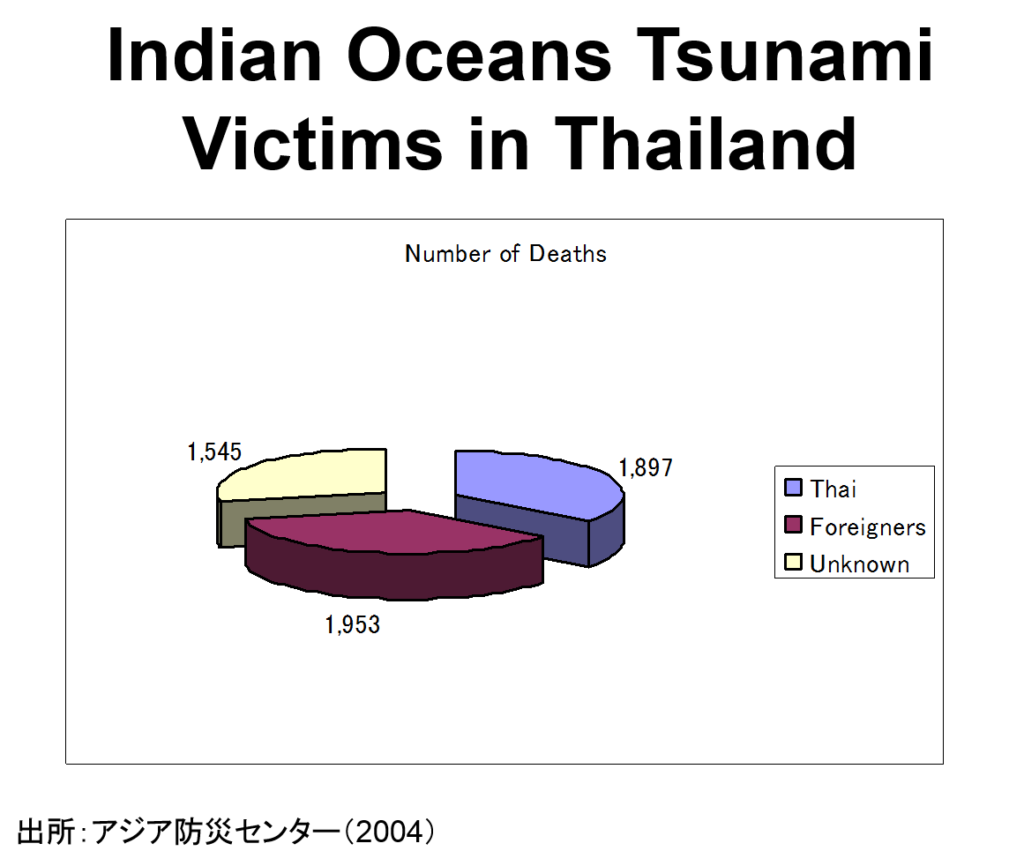
Figure 3 Indian Oceans Tsunami Victims in Thailand
The victim’s nationality is so diverse.Figure 4 indicates the top 10 deadliest disasters (actually top 6 exist) in Sweden and you can know the Indian ocean tsunami is ironically the worst natural disaster in the history of Sweden (The fatality number is 543 Wikipedia).

Figure 4 Deadliest Disasters in Sweden (1900-2014) Source: EM-DAT
[ad#ads1]
Day_93: Natural disasters in Thailand – National Disaster Risk Assessement Mapping
Day_18 mentioned “More must be done to fight climate change” (Bangkok Post)
https://disasterresearchnotes.site/archives/2304
The national risk assessment mapping in Thailand is briefly explained below.
Table 1 Disaster data in Thailand
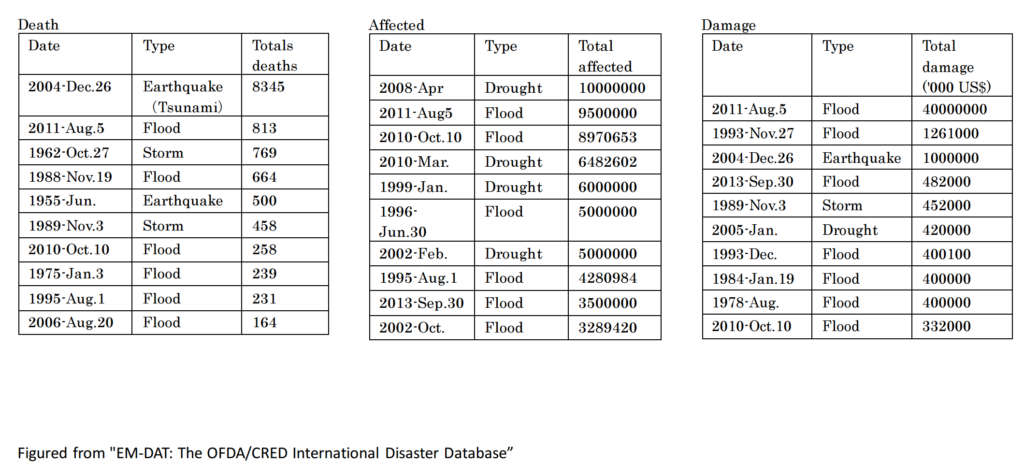
A target period of these EM-DAT data is from 1900 to 2014. However, the large numbers of death, affected people, and damage cost caused by natural disasters are all after 1970s as shown in Table 1. The data clarify the 2004 Indian Ocean Tsunami and the 2011 Chao Phraya river flood disasters are so influential in Thailand.
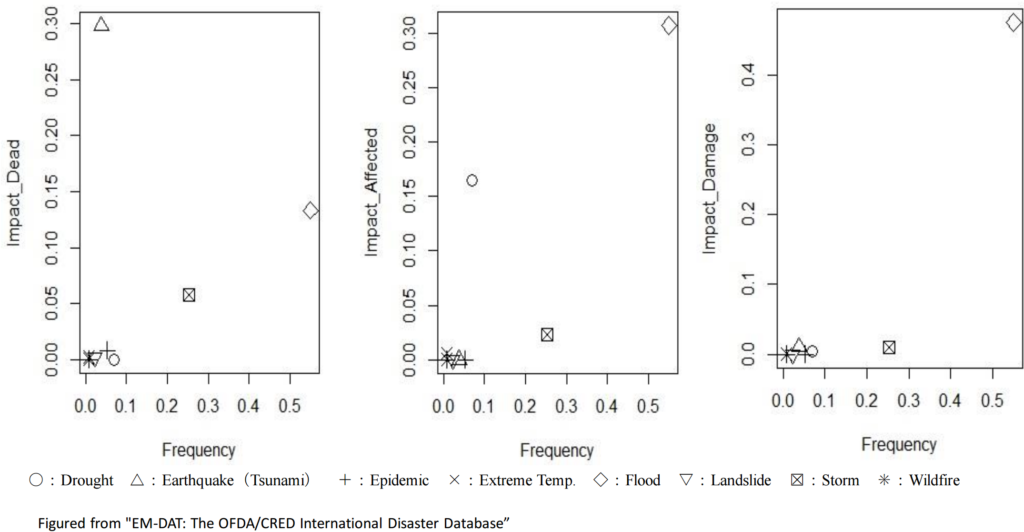
Figure 1 National Risk Assessment Mapping in Thailand
Using EM-DAT data of Thailand (1900-2014), Figure 1 was created. These risk assessment mapping (Frequency-Impact by each damage type) is very simple, but we can easily grasp the whole pictures of the risks.
To evaluate each risk, the following risk matrix options are useful.
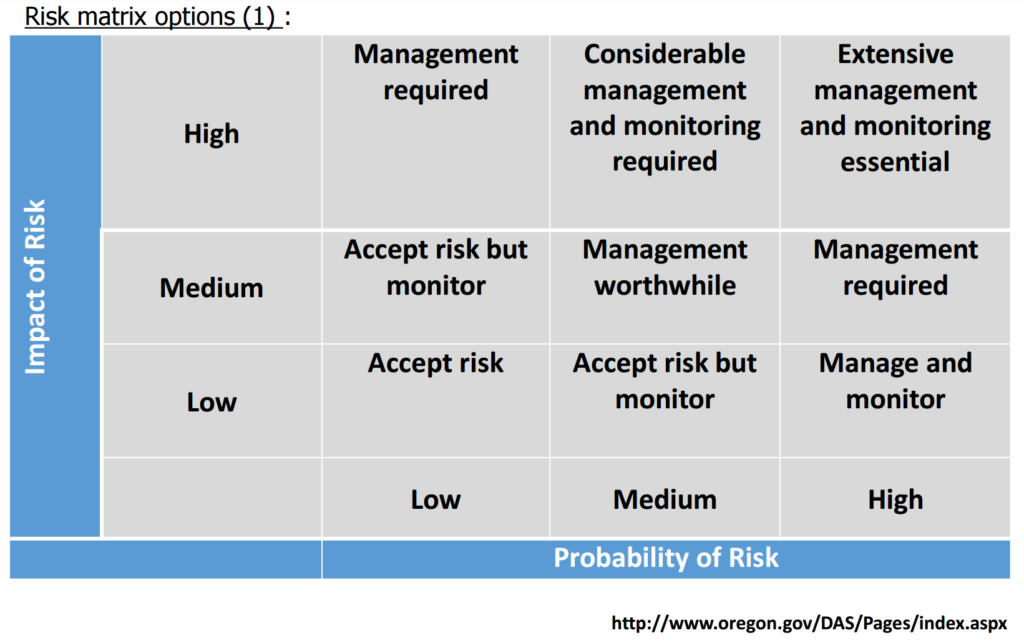
Figure 2 Risk matrix options (1)
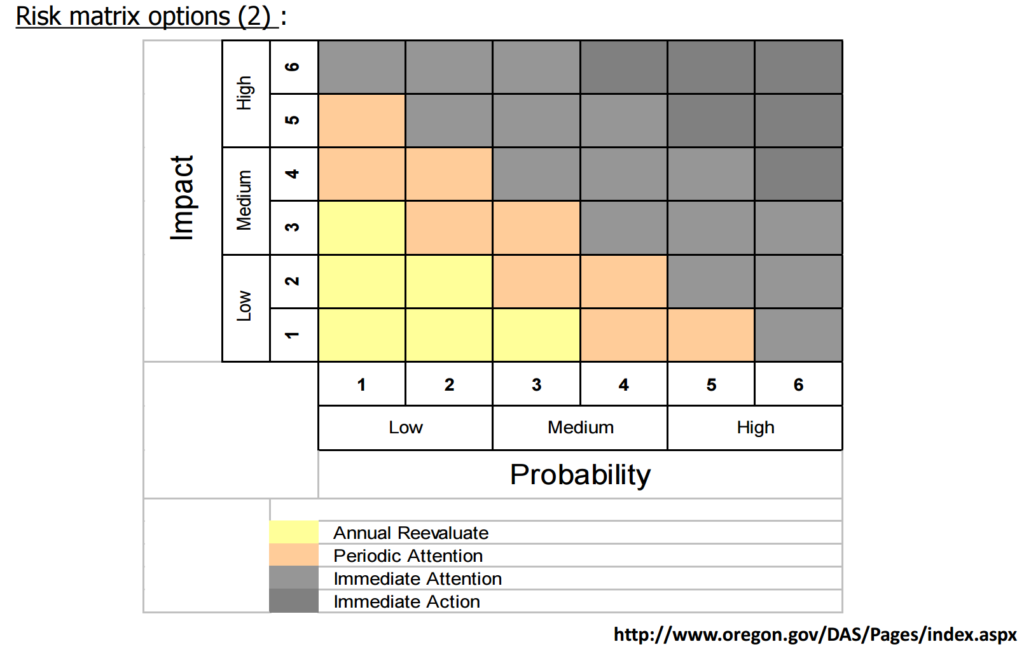
Figure 3 Risk matrix options (2)
It is clear that the flood is the most countermeasures required disaster in Thailand from the Figure1. By using Figure 2 and 3, for example, we can recognize the extensive management and monitoring are essential and immediate action must be taken against the floods.
The above explanations are very rough. Detailed explanations will be discussed later.
The above was already published with explanations as a report for the Japanese Association for Earthquake and Engineering (JAEE).
Day_68 : Aging Asia to Natural Disasters -Thailand-
Many Asian countries are facing an aging society. For instance, the Thai population in 2012 was 64,460,000 and the proportion of those over 65 is 8.6 percent compared to 3.1 percent in 1970. This shows that Thailand is facing an aging society and the World Population Prospects* predicts this trend will accelerate. This situation is not exclusively in Thailand, but can likewise be viewed in almost all Asian nations. In addition, Asia is the most vulnerable in terms of natural disasters such as 7 of 10 of the deadliest natural disasters (1980-2014) took place in this region.
World bank notice**:
The Thai population is aging rapidly. The declining share of the working age population will affect economic growth.
– As of 2016, 11% of the Thai population (about 7.5 million people) are 65 years or older, compared to 5% in 1995.
-By 2040, it is projected that 17 million Thais will be 65 years or older – more than a quarter of the population.
-Together with China, Thailand has the highest share of elderly people of any developing country in East Asia and the Pacific.
-The primary driver of aging has been the steep decline in fertility rates, which fell from 6.1 in 1965 to 1.5 in 2015, as a result of rising incomes and education levels and the successful National Family Planning Program launched in 1970.
-The working age population is expected to shrink by around 11% as a share of the total population between now and 2040 – from 49 million people to around 40.5 million people.
-This decline in the working-age population is higher in Thailand than in all other developing East Asia and Pacific countries, including China.
* World Population Prospects
https://esa.un.org/unpd/wpp/
** World Bank, 2016
Thailand Economic Monitor – June 2016: Aging Society and Economy
Disaster data and statistics can be referred by the following link:
http://www.preventionweb.net/english/professional/statistics/




